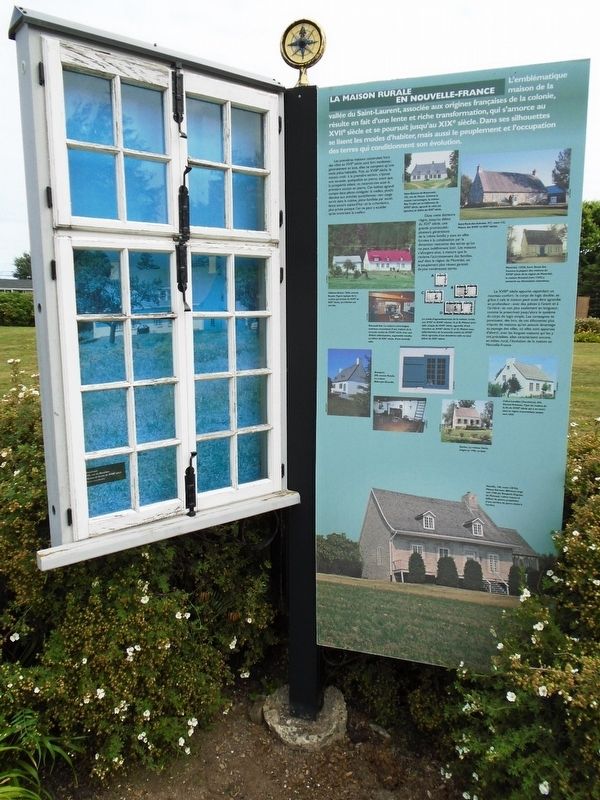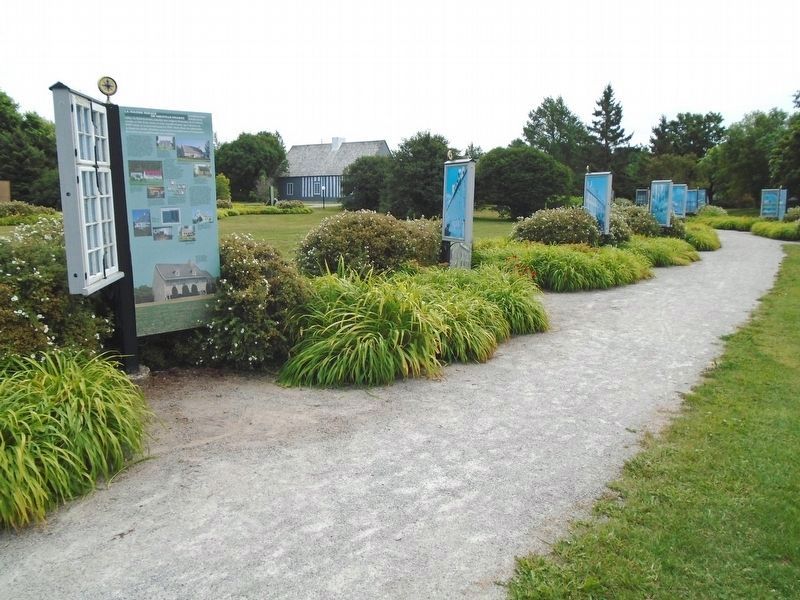La maison rurale en Nouvelle-France / The Rural House in New France
L'emblématique maison de la vallée du Saint-Laurent, associée aux origines françaises de la colonie, résulte en fait d'une lente et riche transformation, qui s'amorce au XVIIe siècle et se poursuit jusqu'aux XIXe siècle. Dans ses silhouettes se lisent les modes d'habiter, mais aussi le peuplement et l'occupation des terres qui conditionnent son évolution.
Les premières maisons construites hors des villes au XVIIe siècle sont fort modestes; généralement en bois, elles ne comptent qu'une seule pièce habitable. Puis, au XVIIIe siècle, la maison croît: à la première section, s'ajoute une seconde, quelquefois en pierre, avant que, la prospérité aidant, on reconstruise aussi la première section en pierre. Cet habitat agrandi compte deux pièces contiguës: la «salle», plutôt dévolue aux activités quotidiennes—son usage survit dans la cuisine, pièce familiale par excellence encore aujourd'hui—et la «chambre», plus privée puisque l'on ne peut y accéder qu'en traversant la «salle».
Dans cette demeure règne, jusqu'au début du XIXe siècle, une grande promiscuité;
plusieurs générations de la même famille y sont en effet forcées à la cohabitation par la dimension restreinte des terres qu'on ne peut indéfiniment lotir. Les maisons s'allongent ainsi, à mesure que le réclame l'accroissement des familles, sauf dans la région de Montréal, où le peuplement plus récent garantit de plus nombreuses terres.Le XVIIIe siècle apporte cependant un nouveau confort: le corps de logis double, et grâce à cela la maison peut aussi être agrandie en profondeur—avec des pièces à l'avant et à l'arrière—et non plus seulement en longueur, comme le prescrivait jusqu'alors le système du corps de logis simple. Les campagnes se ponctuent, dès lors, de ces silhouettes plus trapues de maisons qu'on associe davantage au paysage des villes, où elles sont apparues d'abord; avec les longues maisons qui les y ont précédées, elles caractérisent encore, en milieu rural, l'évolution de la maison en Nouvelle-France.
[Légendes des illustrations, dans le sens des aiguilles d'une montre à partir du centre, lire]
• Saint-Étienne-de-Beaumont. 193, rue du Fleuve.
Comme la maison Lamontagne, la maison Roy-Trudel est un bâtiment
du XVIIIe siècle, agrandi du côté est (gauche) au début du XIXe siècle.
• Saint-Roch-des-Aulnaies. 977, route 132.
Maison des XVIIIe et XIXe siècles.
Comme la plupart des maisons du XVIIIe siècle de la région de Montréal,
la maison Armand (vers 1735) a conservé ses dimensions restreintes.
• Calixa-Lavallée (Verchères). 694, Second Ruisseau.
Type de maison de la fin du XVIIIe siècle qui a eu cours dans la région montréalaise jusque vers 1820.
• Dorion. La maison Valois, érigée en 1796, en bois.
• Beauport. 600, avenue Royale. La maison Bellanger-Girardin.
• Rimouski-Est. La maison Lamontagne.
Intérieur reconstitué d'une maison de la seconde moitié du XVIIIe siècle avec une division salle/chambre, augmentée ensuite, au début du XIXe siècle, d'une seconde salle.
• Le mode d'agrandissement de la maison rurale aux XVIIe et XVIIIe siècles: A et B, Maison avec salle unique du XVIIe siècle, agrandie d'une chambre au XVIIIe siècle; C et D, Maison avec salle/chambre de la seconde moitié du XVIIIe siècle agrandie d'une deuxième salle au tout début du XIXe siècle.
• Château-Richer, 7650, avenue Royale. Figure typique de la maison qui évolue du XVIIe au XIXe siècle, en s'étirant sur son site.
[La légende de la grande photo du bas se lit]
Neuville. 138, route 138 Est.
Maison Darveau. Bâtiment érigé vers
maître maçon et tailleur de pierre, propiétaire d'une carrière de pierre située à l'arrière.
[La légende de la photo d'arrière-plan de la fenêtre se lit]
Boischatel
248, rue du Bataillon
Maison de ferme du XVIIIe siècle
The emblematic house of the St. Lawrence Valley, associated with the French origins of the colony, was actually a slow and rich transformation, which began in the seventeenth century and continued until the nineteenth century. In these silhouettes are read the modes of living, but also of the settlement and the occupation of the lands which conditioned its evolution.
The first houses built outside cities in the seventeenth century were very modest; usually made of wood, and only having one habitable room. Then, in the eighteenth century, the house grew: to the first section was added a second, sometimes in stone, before, due to prosperity, they rebuilt the first section in stone. This enlarged living space had two adjoining rooms: a "room" mainly devoted to daily activities-its use survived as the kitchen, a family room par excellence still used today-and a "room," more private because it could not be accessed but only through the other "room."
Until the beginning of the 19th century, family mingling reigned in this house as several generations of the same family were forced to cohabit due to the limited availability of land that could not be further divided. Houses became larger as the demand for more settlers increased, except in the Montreal area where newer settlement allowed more land per family.
[Illustration captions, clockwise from top center, read]
• Saint-Roch-des-Aulnaies. 977 Route 132.
• Montreal. 12930, boul. Gouin Est.
Like most 18th century houses in the Montreal area,
• Calixa-Lavallée (Verchères). 694, Second Ruisseau.
• Dorion. The Valois house, built of wood in 1796.
• Beauport. 600, avenue Royale. The Bellanger-Girardin house.
• Rimouski Est. The Lamontagne house.
• The extension of the rural house in the seventeenth and eighteenth centuries: A and B, House with unique seventeenth century room, enlarged room in the eighteenth century; C and D, House with room/room of the second half of the eighteenth century enlarged with a second room at the beginning of the nineteenth century.
• Château-Richer, 7650, avenue Royale. Typical figure of the house that evolved from the seventeenth to the nineteenth century, enlarged over time.
[Large bottom photo caption reads]
[Window background photo caption reads]
• Saint-Etienne-de-Beaumont. 193, rue du Fleuve.
Like Lamontagne House, the Roy-Trudel House is an 18th-century building,
enlarged on the east (left) side at the beginning of the 19th century.
House of the eighteenth and nineteenth centuries.
the Armand House (circa 1735) has kept its small size.
Type of house in the Montreal area from the late eighteenth century until around 1820.
Interior reconstruction of a second half of the eighteenth century house with a room/room division,
later increased in the early nineteenth century with a second room.
Neuville. 138 Route 138 East.
Darveau House. Building erected around 1780 by Benjamin Deguise, said Flamand,
master mason and stonemason, owner of a stone quarry at the back.
Boischatel
248, rue du Bataillon
18th century farmhouse
Topics. This historical marker is listed in these topic lists: Architecture • Settlements & Settlers. A significant historical year for this entry is 1725.
Location. 48° 29.069′ N, 68° 29.756′ W. Marker is in Rimouski, Québec, in Rimouski-Neigette. Marker is on boulevard du Rivage (Québec Route 132), on the right when traveling north. Marker is on the grounds of Maison Lamontagne House Historic Site. Touch for map. Marker is at or near this postal address: 707 boulevard du Rivage, Rimouski QC G5L 7L3, Canada. Touch for directions.
Other nearby markers. At least 8 other markers are within walking distance of this marker. La maison urbaine en Nouvelle-France / The Urban House in New France (here, next to this marker); La maison Londonienne / The London house (a few steps from this marker); Villas et villégiature / Villas and Resorts (a few steps from this marker); La maison rurale du Bas-Canada / The Rural House of Lower Canada (a few steps from this marker); Maisons des faubourgs / Suburban Houses (within shouting distance of this marker); L'habitat ouvrier urbain / Urban Worker Housing (within shouting distance of this marker); Les maisons de notables / Noteworthy Houses (within shouting distance of this marker); Un jeu de blocs... d'argile / A set of blocks ... of clay (within shouting distance of this marker). Touch for a list and map of all markers in Rimouski.
Also see . . .
1. The Architecture of Old Quebec, or The History of a Palimpsest (Noppen and Morisett). (Submitted on May 4, 2019, by William Fischer, Jr. of Scranton, Pennsylvania.)
2. Maison Lamontagne House Historic Site. (Submitted on May 4, 2019, by William Fischer, Jr. of Scranton, Pennsylvania.)
Credits. This page was last revised on January 20, 2020. It was originally submitted on May 4, 2019, by William Fischer, Jr. of Scranton, Pennsylvania. This page has been viewed 221 times since then and 18 times this year. Photos: 1, 2. submitted on May 5, 2019, by William Fischer, Jr. of Scranton, Pennsylvania.

